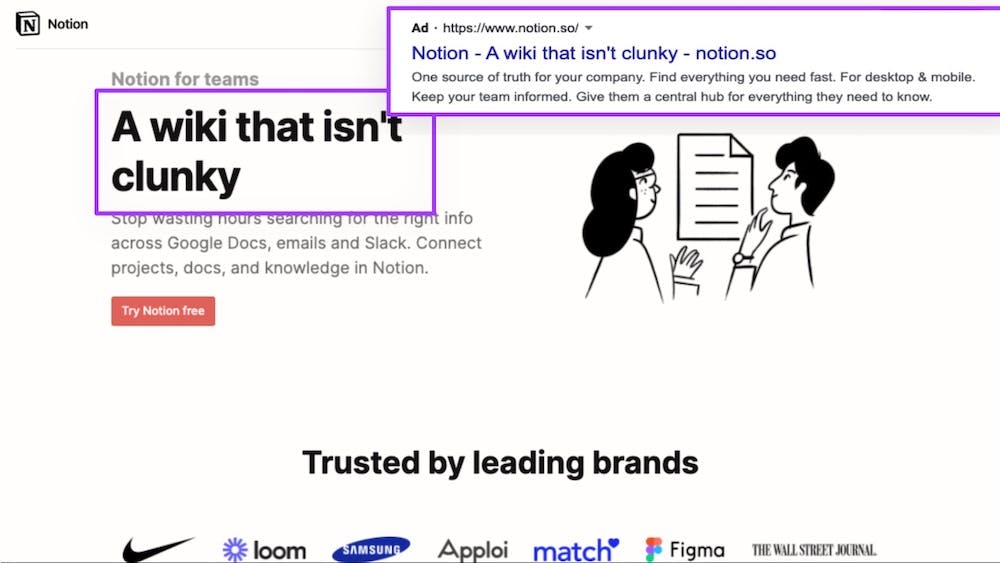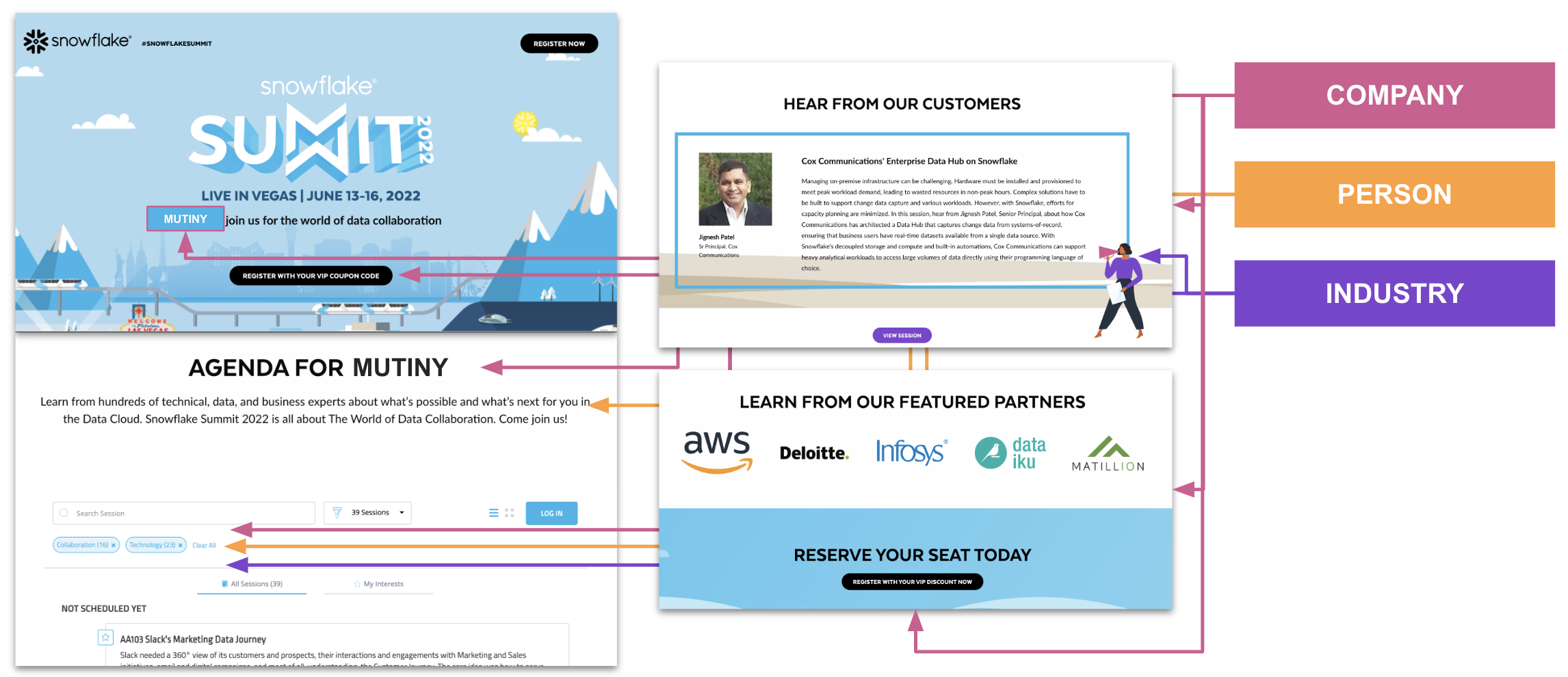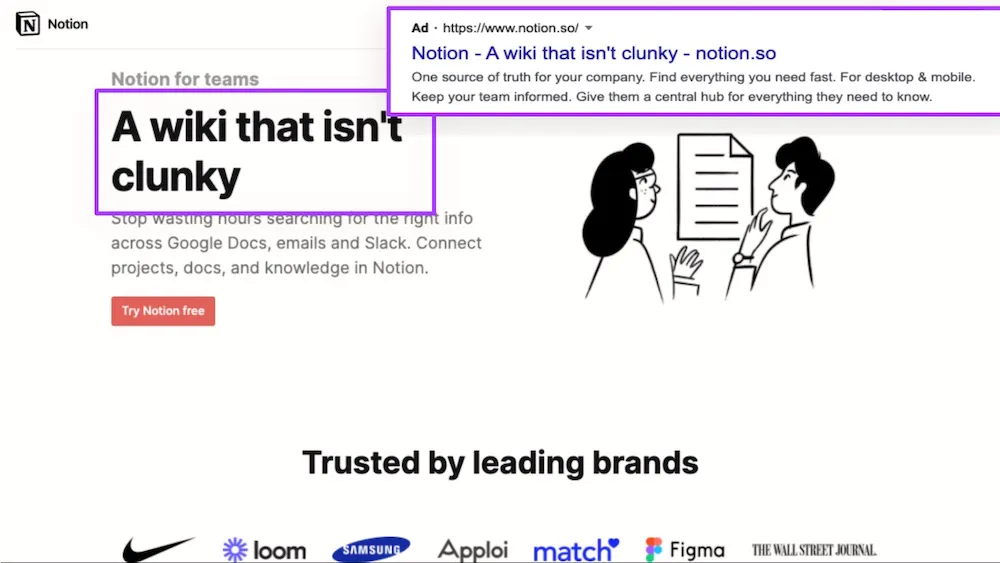by Stewart Hillhouse for Mutiny
The Efficient Growth Tour gathered CMOs and marketing leaders to learn how to drive measurable impact despite the turbulent market conditions of 2023. An executive panel featuring Emily Kramer (Co-Founder, MKT1), Mac McConnell (SVP of Marketing, Flexa), and Robin Spencer (Advisor, Clearbit) unpacked some key concepts that they’ve learned over their careers for making sure the marketing team is driving efficient growth.
One concept that everyone on the panel had strong opinions on was using your company’s ideal customer persona (ICP) as an important tool in your marketing team’s growth toolbox. Read on to learn three ways that you can get more value from your ICP and how to use it to deliver revenue-generating impact.
Don’t Go To Market Alone: how to align your ICP with sales and product
When Emily was Head of Marketing at Asana, she had the blessing and the curse of having a very large potential audience — pretty much anyone who works from a computer could use their product. But that isn’t useful for helping you build a go-to-market motion (GTM) that will effectively capture the demand of your ICPs.
Emily recommends working backwards from your organization’s business model to determine who in your organization you need to be clear on your target ICP the most.
If you’re a product-led GTM motion
If you acquire customers largely through self-service demos or trials, you’ll have to be working in lockstep with the product team. This will make sure your marketing efforts are going towards channels that will generate traffic to high-converting pages on your website.
For example, Notion drives a large amount of traffic from paid sources to a personalized landing page to open an account. If marketing and product aren’t aligned on who the high value ICPs are, they could be wasting their time and resources acquiring users who are a bad fit for the product.

If you’re a sales-led GTM motion
For hybrid or sales-led motions, you have to bring a sales leader into collaborate over defining ICPs. This is especially important if your company is targeting enterprise-level prospects, as you want to get in front of the right people in a strategic way. Account-based marketing (ABM) programs are a strong example of how sales and marketing can define and align around an ICP.
When Snowflake ran their largest event of the year, they identified 1,600 key attendees, all from high-value accounts that they wanted to attend. They sent each of these people personalized landing pages inviting them to the event and recommending what kind of content sessions would be most interesting to them. Doing ABM plays like this at scale is only possible when you’ve got a clear ICP.

Pro Tip: Don’t overlook how your customer support and success team when pressure testing your ICP. Mac recommends identifying your bad-fit customers by connecting with your support leaders to learn which customers generate the highest ticket volume. If they’re struggling to use your product and have a high likelihood of churn, then maybe they might not be worth the headache of acquiring them as a customer at this stage in your company’s maturity.
How to prioritize if you have multiple ICPs
If you’ve got multiple ICPs, prioritize them based on revenue value, length of sales cycle, and cost of acquisition. Emily uses a tiered system to make it clear who the marketing team is prioritizing. Here’s how that breaks down:
- Tier 1 – These are the primary audiences marketing is going after with all activities explicitly listed out.
- Tier 2 – These are the audiences your team is not quite ready to scale out yet so you’re doing fewer activities around them compared to Tier 1.
- Tier 3 – These are the ICPs you’re testing to see if you should pursue further through either a single campaign or piece of content.
Emily also suggests using this tiering system for “communicating out what marketing is doing for each of these audiences to prevent just crazy amounts of requests”. This also prevents investing too much in ICPs that aren’t proven out.
Be Specific: go beyond ad platform targeting
As convenient as technology can be, it can also sometimes create shortcuts that undercut the rest of your work. Emily sees one particular pitfall over and over from working with dozens of organizations as part of her work at MKT1 Capital:
“A big mistake people make is they only think about defining their ICP as the segmentation rules you’ll use to target them on various ads or outbound platforms.”
Mac went on to clarify that there’s a major difference between your total addressable market and your ICP.
“For me, the definition of ICP is: who’s really going to be successful with my product?“
It’s simple, but that’s the point. You should be able to describe your ICP in a single sentence when asked, rather than just rattle off ad-targeting parameters.
By being specific around who your ICP is, you’ll be able to do further audience research to understand:
- The challenges in their workflows
- Their current tech stack
- Their goals and responsibilities.
As Mac reminds us, “We now live in this data-rich world, where there are tens if not hundreds of attributes you have access to. Your ideal customer profile should be hyper-specific.”
Many companies go too broad with their targeting in fear of not meeting their business goals. Mac cautions against falling for broad strokes, “My ICP may be so specific that I can’t get a big enough audience. That is a great problem to have. Now I can start removing key attributes and open the picture up just enough that I can stay focused on those accounts.”
Use It Or Lose It: Make your ICP part of your marketing workflow
“People spend a lot of time on these exercises to define their ICP and they just never look at it again,” says Emily.
These ICPs can be included with every brief your marketing team works on. Emily advocates for answering these questions in every brief to ensure you’re working on something meaningful for your ICP:
Goals
- What objective or key results does this support?
- Why is now the right time to focus on it?
Audience
- Who is the primary ICP we’re making this for?
- Are we targeting prospects? Existing customers? Both?
Creative
- How will we make this work stand out? What do we want our target audience to see/feel/think/do?
- What are the design and creative requirements?
Channels
- What will be the primary channel for distribution?
- How are we going to get mileage out of the assets created?
Stakeholders
- Who is the individual who owns this project?
- Who else will be involved? In what capacity?
Emily says, “This is high-level metadata on every single project. When we use Asana, we put it in the project tab. When we use Google Docs, it’s at the top of the doc. It’s everywhere.”
A word to the wise though — Emily adds, “This brief doesn’t work unless everyone understands the ICP upfront and understands the data of how you segment to get to them and the qualitative research about them.”
Emily has put together a full GACCS framework – learn more about how to implement this into your workflow here. Her newsletter is a must read for every marketer looking to lead a team and uplevel their impact on the business.
